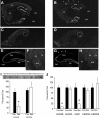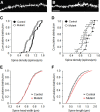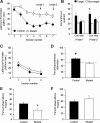Loss of GluN2B-containing NMDA receptors in CA1 hippocampus and cortex impairs long-term depression, reduces dendritic spine density, and disrupts learning
- PMID: 20357110
- PMCID: PMC2869199
- DOI: 10.1523/JNEUROSCI.0640-10.2010
Loss of GluN2B-containing NMDA receptors in CA1 hippocampus and cortex impairs long-term depression, reduces dendritic spine density, and disrupts learning
Abstract
NMDA receptors (NMDARs) are key mediators of certain forms of synaptic plasticity and learning. NMDAR complexes are heteromers composed of an obligatory GluN1 subunit and one or more GluN2 (GluN2A-GluN2D) subunits. Different subunits confer distinct physiological and molecular properties to NMDARs, but their contribution to synaptic plasticity and learning in the adult brain remains uncertain. Here, we generated mice lacking GluN2B in pyramidal neurons of cortex and CA1 subregion of hippocampus. We found that hippocampal principal neurons of adult GluN2B mutants had faster decaying NMDAR-mediated EPSCs than nonmutant controls and were insensitive to GluN2B but not NMDAR antagonism. A subsaturating form of hippocampal long-term potentiation (LTP) was impaired in the mutants, whereas a saturating form of LTP was intact. An NMDAR-dependent form of long-term depression (LTD) produced by low-frequency stimulation combined with glutamate transporter inhibition was abolished in the mutants. Additionally, mutants exhibited decreased dendritic spine density in CA1 hippocampal neurons compared with controls. On multiple assays for corticohippocampal-mediated learning and memory (hidden platform Morris water maze, T-maze spontaneous alternation, and pavlovian trace fear conditioning), mutants were impaired. These data further demonstrate the importance of GluN2B for synaptic plasticity in the adult hippocampus and suggest a particularly critical role in LTD, at least the form studied here. The finding that loss of GluN2B was sufficient to cause learning deficits illustrates the contribution of GluN2B-mediated forms of plasticity to memory formation, with implications for elucidating NMDAR-related dysfunction in disease-related cognitive impairment.
Figures





Similar articles
-
Individual NMDA receptor GluN2 subunit signaling domains differentially regulate the postnatal maturation of hippocampal excitatory synaptic transmission and plasticity but not dendritic morphology.Synapse. 2024 Jul;78(4):e22292. doi: 10.1002/syn.22292. Synapse. 2024. PMID: 38813758 Free PMC article.
-
Presynaptic Spike Timing-Dependent Long-Term Depression in the Mouse Hippocampus.Cereb Cortex. 2016 Aug;26(8):3637-3654. doi: 10.1093/cercor/bhw172. Epub 2016 Jun 9. Cereb Cortex. 2016. PMID: 27282393 Free PMC article.
-
17β estradiol recruits GluN2B-containing NMDARs and ERK during induction of long-term potentiation at temporoammonic-CA1 synapses.Hippocampus. 2016 Jan;26(1):110-7. doi: 10.1002/hipo.22495. Epub 2015 Oct 1. Hippocampus. 2016. PMID: 26190171 Free PMC article.
-
Long-term potentiation and the role of N-methyl-D-aspartate receptors.Brain Res. 2015 Sep 24;1621:5-16. doi: 10.1016/j.brainres.2015.01.016. Epub 2015 Jan 22. Brain Res. 2015. PMID: 25619552 Free PMC article. Review.
-
GluN2A and GluN2B subunit-containing NMDA receptors in hippocampal plasticity.Philos Trans R Soc Lond B Biol Sci. 2013 Dec 2;369(1633):20130163. doi: 10.1098/rstb.2013.0163. Print 2014 Jan 5. Philos Trans R Soc Lond B Biol Sci. 2013. PMID: 24298164 Free PMC article. Review.
Cited by
-
Using genetically engineered animal models in the postgenomic era to understand gene function in alcoholism.Alcohol Res. 2012;34(3):282-91. Alcohol Res. 2012. PMID: 23134044 Free PMC article.
-
Surface expression of hippocampal NMDA GluN2B receptors regulated by fear conditioning determines its contribution to memory consolidation in adult rats.Sci Rep. 2016 Aug 4;6:30743. doi: 10.1038/srep30743. Sci Rep. 2016. PMID: 27487820 Free PMC article.
-
Involvement of Cdk5 activating subunit p35 in synaptic plasticity in excitatory and inhibitory neurons.Mol Brain. 2022 Apr 28;15(1):37. doi: 10.1186/s13041-022-00922-x. Mol Brain. 2022. PMID: 35484559 Free PMC article.
-
Cortico-hippocampal GluN2B is essential for efficient visual-spatial discrimination learning in a touchscreen paradigm.Neurobiol Learn Mem. 2018 Dec;156:60-67. doi: 10.1016/j.nlm.2018.10.011. Epub 2018 Oct 27. Neurobiol Learn Mem. 2018. PMID: 30394331 Free PMC article.
-
Role of Cdk5 in Kalirin7-Mediated Formation of Dendritic Spines.Neurochem Res. 2019 May;44(5):1243-1251. doi: 10.1007/s11064-019-02771-y. Epub 2019 Mar 14. Neurochem Res. 2019. PMID: 30875016
References
-
- Akashi K, Kakizaki T, Kamiya H, Fukaya M, Yamasaki M, Abe M, Natsume R, Watanabe M, Sakimura K. NMDA receptor GluN2B (GluRε2/NR2B) subunit is crucial for channel function, postsynaptic macromolecular organization, and actin cytoskeleton at hippocampal CA3 synapses. J Neurosci. 2009;29:10869–10882. - PMC - PubMed
-
- Alvarez VA, Sabatini BL. Anatomical and physiological plasticity of dendritic spines. Annu Rev Neurosci. 2007;30:79–97. - PubMed
-
- Bannerman DM, Rawlins JN, Good MA. The drugs don't work-or do they? Pharmacological and transgenic studies of the contribution of NMDA and GluR-A-containing AMPA receptors to hippocampal-dependent memory. Psychopharmacology (Berl) 2006;188:552–566. - PubMed
-
- Bannerman DM, Niewoehner B, Lyon L, Romberg C, Schmitt WB, Taylor A, Sanderson DJ, Cottam J, Sprengel R, Seeburg PH, Köhr G, Rawlins JN. NMDA receptor subunit NR2A is required for rapidly acquired spatial working memory but not incremental spatial reference memory. J Neurosci. 2008;28:3623–3630. - PMC - PubMed
-
- Barria A, Malinow R. NMDA receptor subunit composition controls synaptic plasticity by regulating binding to CaMKII. Neuron. 2005;48:289–301. - PubMed
Publication types
MeSH terms
Substances
Grants and funding
LinkOut - more resources
Full Text Sources
Other Literature Sources
Molecular Biology Databases
Miscellaneous
